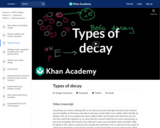
Alpha, Beta, Gamma Decay and Positron Emission. Created by Sal Khan.
- Subject:
- Physical Science
- Physics
- Material Type:
- Lesson
- Provider:
- Khan Academy
- Provider Set:
- Khan Academy
- Author:
- Sal Khan
- Date Added:
- 09/11/2009

Alpha, Beta, Gamma Decay and Positron Emission. Created by Sal Khan.

Introduction to Exponential Decay. Using the exponential decay formula to calculate k, calculating the mass of carbon-14 remaining after a given time, and calculating the time it takes to have a specific mass remaining . Created by Sal Khan.
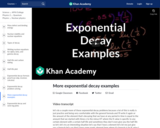
A few more examples of exponential decay. Practice calculating k from half-life, and calculating initial mass. Created by Sal Khan.
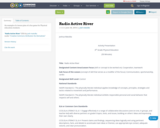
An example of a lesson plan of a fun game for Physical education students.
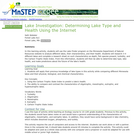
This activity is an on-line research activity in which students research different Minnesota lakes and determine their physical characteristics, chemical characteristics, and the overall health of the lake.

In this activity, students will learn about and apply the Laws of Physics to successfully launch and land a raw egg. The activity frames the problem around designing and building a bottle rocket that will protect a raw egg being launched into the air at least seven meters. Resources included in this lesson are found at the bottom of this document and include:
-Teacher guide
-Physics note sheets on motion, speed, velocity, acceleration, momentum, force, friction, Newton’s Laws of Motion, potential and kinetic energy and gravity.
-Egg Launch Instructions
-Link to Bottle Rocket Launching Instructions
-Links to videos
-Post Assessment
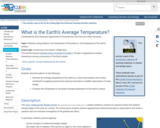
This short, pedagogically flexible activity guides students to answer six questions about the radiative energy budget of the earth as a whole. The activity gives students practice applying basic physical principles to observations and raises a question that can motivate investigation of the greenhouse effect.
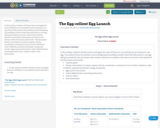
In this activity, students will learn about and apply the Laws of Physics to successfully launch and land a raw egg. The activity frames the problem around designing and building a bottle rocket that will protect a raw egg being launched into the air at least seven meters. Resources included in this lesson are found at the bottom of this document and include:
-Teacher guide
-Physics note sheets on motion, speed, velocity, acceleration, momentum, force, friction, Newton’s Laws of Motion, potential and kinetic energy and gravity.
-Egg Launch Instructions
-Link to Bottle Rocket Launching Instructions
-Links to videos
-Post Assessment

In this activity, students demonstrate the relationship between wave frequency and energy in the electromagnetic spectrum by shaking a rope to identify the relationships. This activity is part of Unit 2 in the Space Based Astronomy guide that contains background information, worksheets, assessments, extensions, and standards.

For Iowa History- Learn about the European Settlement of Iowa Land 1833 to Statehood in 1846• Video narrative written by Sandra Kessler Host researcher, auth...
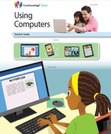
The goal of this 10 lesson, grade 2 unit, is for young students to continue using computer devices with increasing independence for various purposes, including game play, communication, and schoolwork..
The key question guiding the unit is: How can we use computers and the internet?
Download the Teacher Guide — containing comprehensive lessons, lesson plans, and a unit overview, and the Student Book — designed as a Read-Aloud.
.
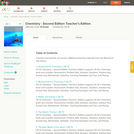
A work in progress, CK-12 Chemistry Teacher's Edition supports its Chemistry book covering: Matter; Atomic Structure; The Elements; Stoichiometry; Chemical Kinetics; Physical States of Matter; Thermodynamics; Nuclear and Organic Chemistry.

In this activity, students will learn the concept of half-life of a radioactive material. Students will create and be able to recognize a graph representing the half-life of an imaginary radioactive element.

Basic physical, cultural and economic elements and their integration on a world and regional basis.
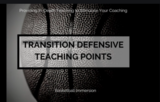
This resource is designed to be used in Health or Physical Education course in a basketball unit.
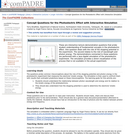
These are interactive lecture-demonstration questions probe student understanding of fundamental concepts in the photoelectric effect.
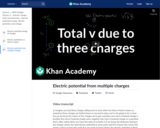
In this video David shows how to find the total electric potential at a point in space due to multiple charges. Created by David SantoPietro.

Using a paper and tape device, students experience how atoms and molecules of gas in Earth’s atmosphere absorb electromagnetic energy through resonance. This activity is part of Unit 2 in the Space Based Astronomy guide that contains background information, worksheets, assessments, extensions, and standards.

This seminar examines the history and legacy of the Cold War on American science. It explores scientist’s new political roles after World War II, ranging from elite policy makers in the nuclear age to victims of domestic anti Communism. It also examines the changing institutions in which the physical sciences and social sciences were conducted during the postwar decades, investigating possible epistemic effects on forms of knowledge. The subject closes by considering the place of science in the post-Cold War era.
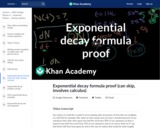
Showing that N(t)=Ne^(-kt) describes the amount of a radioactive substance we have at time T. For students with background in Calculus. Not necessary for intro chemistry class. Created by Sal Khan.